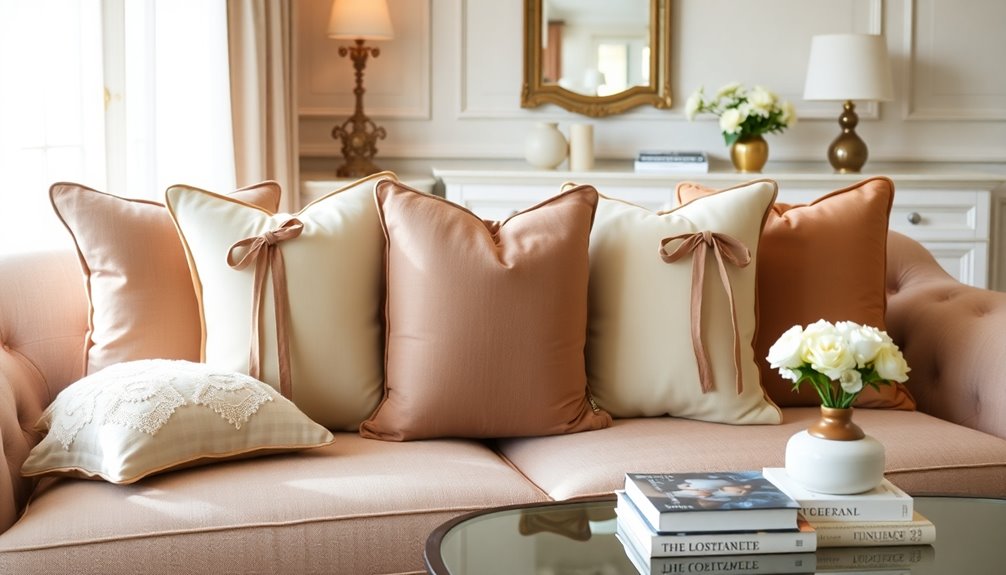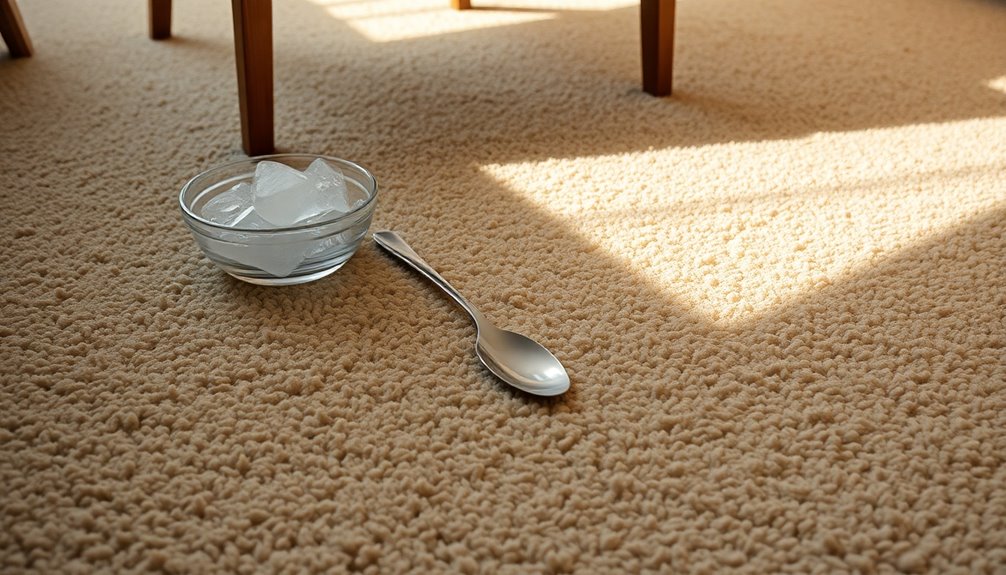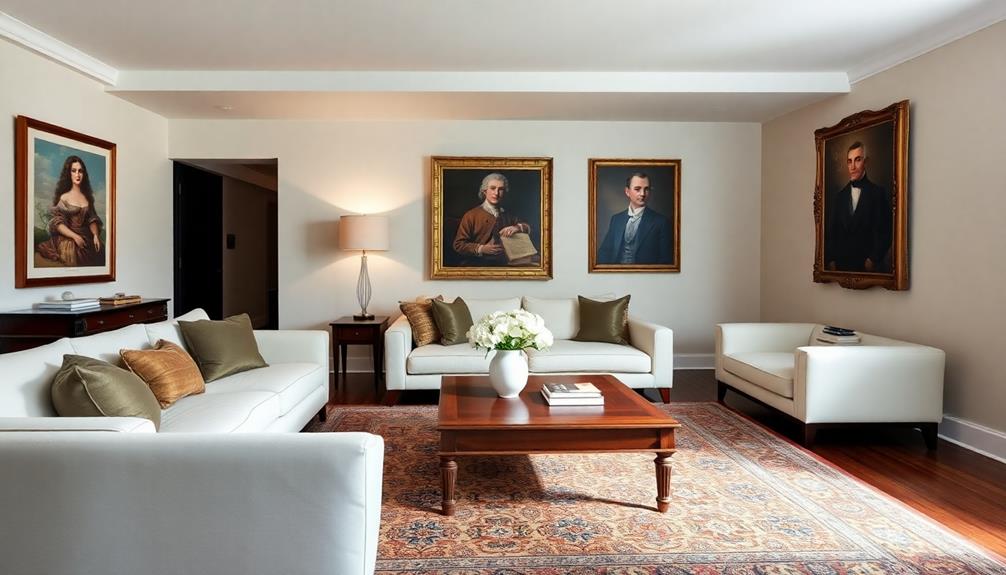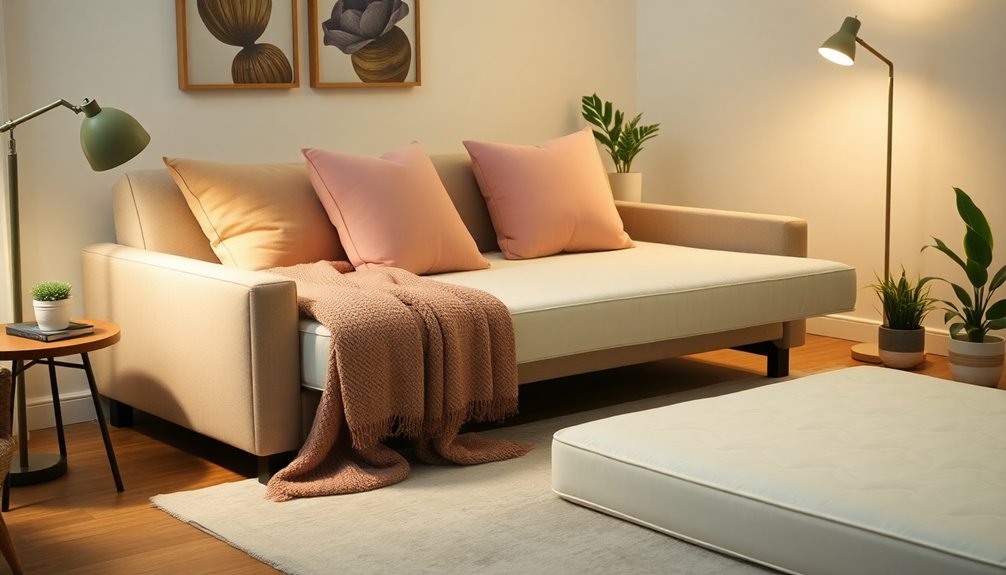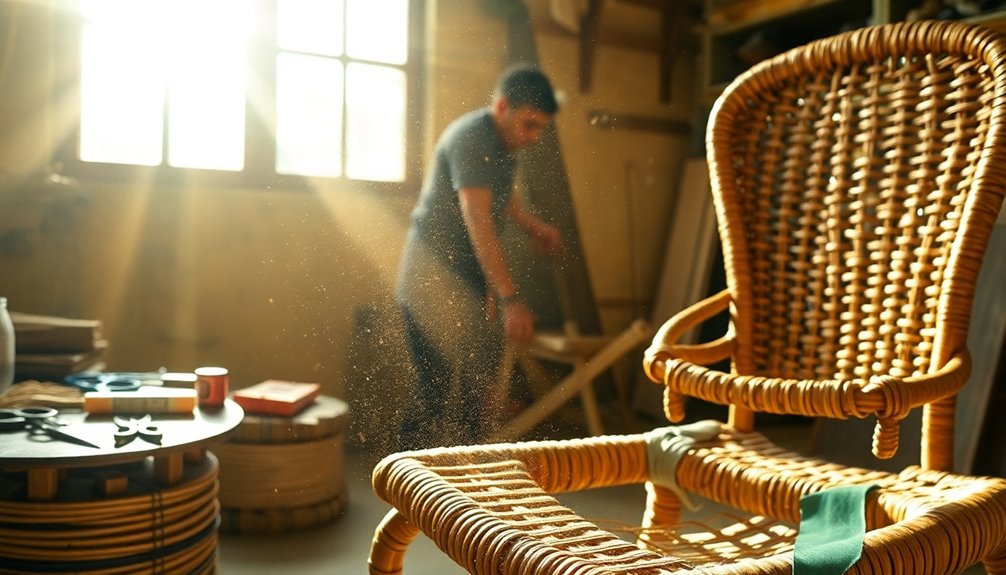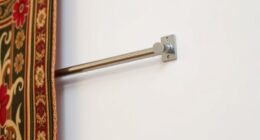To keep your sofa back cushions in place, start by fluffing them regularly to maintain shape and support. Choose high-density foam cushions for a snug fit and consider adding Velcro or hook-and-loop attachments to prevent shifting. Tuck throw blankets into the cushions for extra grip, and regularly inspect the cushion frame for any signs of wear. If you have pets, opt for claw-resistant fabrics and use coasters on armrests to minimize friction. Making sure cushions fit well is key, and there's more to explore to enhance your sofa's comfort and stability.
Key Takeaways
- Use high-density foam cushions for a snug fit that enhances stability and reduces shifting.
- Incorporate Velcro or hook-and-loop attachments to secure cushions in place.
- Regularly fluff and rotate back cushions to maintain their shape and prevent sagging.
- Employ non-slip pads or coasters to bolster the position of slightly smaller cushions.
- Ensure proper measurement of frame dimensions for a perfect cushion fit to minimize movement.
Introduction
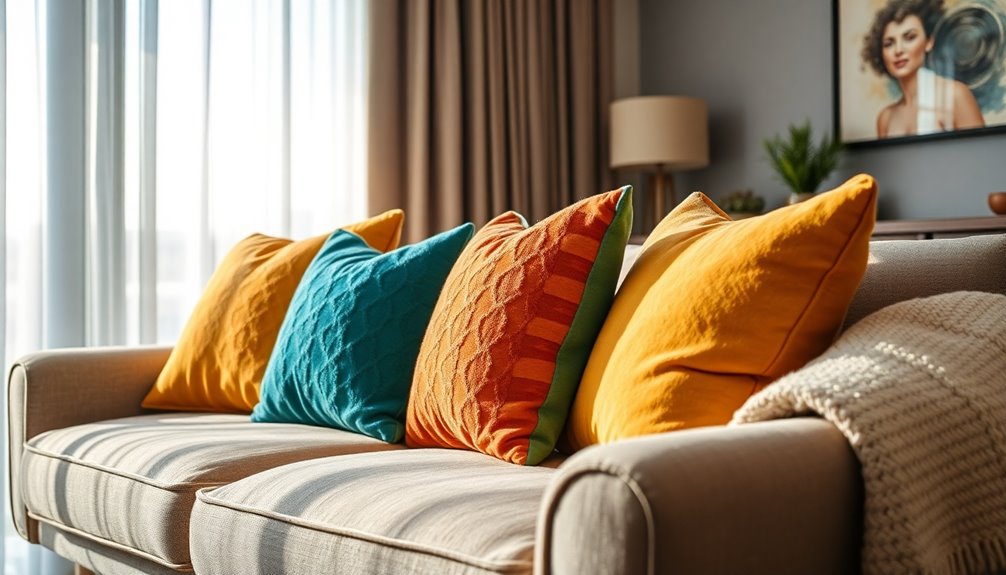
Keeping your sofa back cushions in place isn't just about securing them; it also involves regular cleaning. Routine dusting and vacuuming help maintain their appearance, while fabric-specific cleaning techniques ensure you're treating stains properly. Don't forget to tackle tough stains like red wine quickly to keep your cushions looking fresh and clean.
Routine Dusting and Vacuuming
Regularly dusting and vacuuming your sofa back cushions is essential for preventing them from sliding or becoming misaligned. Over time, dirt and debris can accumulate, reducing friction and causing your cushions to shift. To combat this, make it a habit to vacuum at least once a week. Use a vacuum with an upholstery attachment to reach both the cushions and the crevices of your couch, ensuring a thorough clean. This routine will not only help maintain the cushions' position but also enhance the overall appearance of your sofa.
Incorporating gentle dusting techniques, like using a soft brush or a lint roller, can further tighten the fabric and keep it in place. These methods help eliminate any remaining dust particles that might contribute to cushion movement. Additionally, regular cleaning prolongs the lifespan of your cushions by preventing wear from trapped dirt.
Fabric-Specific Cleaning Techniques
When it comes to maintaining the appearance and longevity of your sofa back cushions, understanding fabric-specific cleaning techniques is crucial. Each upholstery fabric requires unique cleaning methods to ensure you don't inadvertently cause damage. For instance, cotton couch cushions can usually be cleaned with water-based solutions, while leather needs specialized cleaners to avoid deterioration.
Always check the manufacturer's care label for specific cleaning instructions. Some fabrics may even be machine washable, while others might need dry cleaning. For synthetic fabrics, mild detergents and a soft brush work wonders in removing stains without harming the fabric's integrity.
Regular vacuuming of your couch cushions helps prevent dust and dirt buildup, maintaining both cleanliness and appearance. When applying any cleaning methods, remember to test the cleaner on a hidden area first. This way, you can ensure it won't cause discoloration or damage.
Treating Red Wine Stains
Red wine stains can be a nightmare for your sofa, but acting swiftly can make all the difference. Start by blotting the stain with a clean cloth to absorb as much excess liquid as possible. Don't rub; just gently press down to prevent the stain from spreading. Once you've blotted, mix equal parts white wine and dish soap. Dab this mixture onto the stain and blot again until the color lifts.
If the stain persists, you might need to try a stronger solution of hydrogen peroxide and dish soap in equal parts. Before applying it, though, test this mixture on an inconspicuous area of your sofa to avoid any potential damage. After treating the stain, rinse the area with cold water and blot dry. If necessary, repeat the cleaning process until the stain disappears.
Always check your upholstery's care label for specific cleaning guidelines. Keeping your cushions stay put while managing stains is essential. If you're dealing with delicate fabrics or stubborn stains, consider professional cleaning to ensure your sofa remains in top shape and your secure couch cushions are protected from future mishaps.
Safeguarding Against Pet Claws
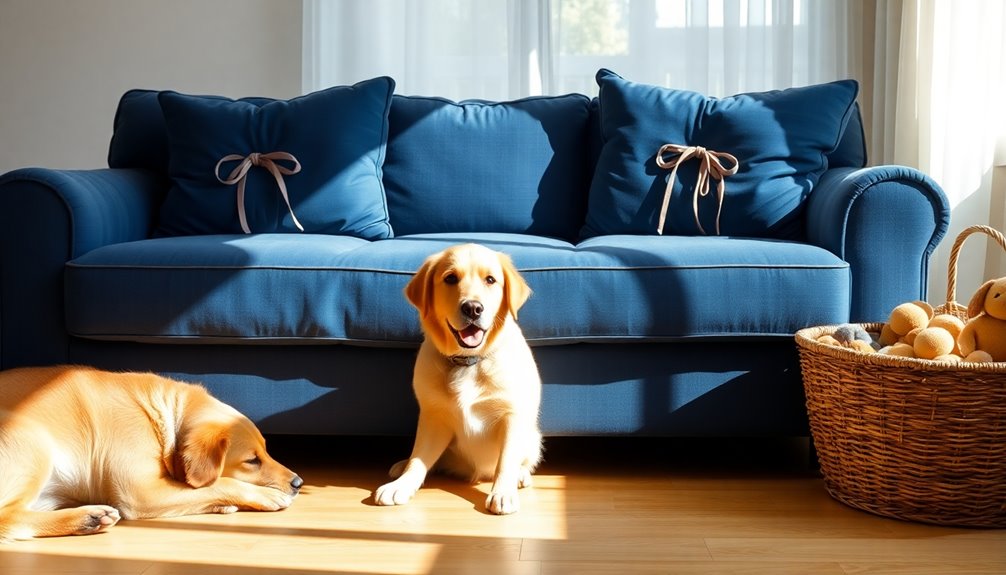
When you have pets, keeping your sofa cushions in place can be a challenge. Choosing claw-resistant fabrics and using throw blankets can help grip the cushions better. You can also minimize friction by placing coasters under the cushions to keep them stable. Regular grooming reduces shedding to help minimize the amount of fur that can get trapped in the cushions.
Claw-Resistant Fabric Choices
Choosing the right fabric for your sofa can make all the difference in protecting it from your furry friends. If you have pets, consider claw-resistant fabrics like microfiber or tightly woven synthetic blends. These materials are specifically designed to withstand pet claws, preventing snags and tears on your cushions. Look for upholstery labeled as “pet-friendly” or “claw-resistant”; they often feature a higher thread count and reinforced fibers for added durability against scratching. Additionally, it’s essential to choose fabrics that are easy to clean, as pet accidents can happen. If you opt for more luxurious options like velvet, be sure to familiarize yourself with how to clean velvet upholstery to maintain its appearance. Regular maintenance and prompt attention to spills will keep your sofa looking fresh, even in a home filled with playful pets.
Outdoor-grade fabrics, such as solution-dyed acrylic, are another excellent option. They not only resist claw damage but also offer easy cleaning for any pet-related stains. When selecting a fabric, opting for darker colors or patterned designs can help conceal any potential scratches and wear marks caused by your pets. Additionally, keeping your home's air quality in check with air purifiers can help reduce allergens that may irritate both pets and humans alike.
Throw Blankets for Grip
There's a simple solution to help keep your sofa back cushions secure: throw blankets. By strategically placing throw blankets over your sofa back cushions, you create additional friction that helps them stay in place. Opt for textured or heavier fabrics, as they provide better grip compared to smooth materials, reducing movement caused by daily use or your furry friends' antics.
To maximize their effectiveness, consider tucking the throw blankets into the back of the cushions or using clips to secure them. This ensures they'll stay in place even during regular use. Plus, choosing throw blankets that are machine washable makes it easy to maintain cleanliness, especially in homes with pets that can contribute to wear and tear. Incorporating textured fabrics adds warmth and comfort to your living space, enhancing the overall aesthetic.
Regularly check the positioning of your throw blankets and adjust them as needed. This not only keeps your cushions secure but also maintains a neat appearance. With these simple steps, you can safeguard your sofa back cushions from sliding and wear, creating a more comfortable and visually appealing living space. Embrace the functionality of throw blankets, and enjoy a cozy, pet-friendly environment.
Minimize Friction With Coasters
To keep your sofa back cushions securely in place, consider using coasters on the armrests. Pets can cause significant friction and movement as they climb or jump onto your furniture. By placing coasters in these areas, you create a smoother surface that helps minimize this friction, preventing the back cushions from shifting.
Opt for coasters made from rubber or silicone, as these materials offer better grip and stability for both drinks and cushions. This way, you protect your upholstery from scratches caused by pet claws, which can lead to increased wear and tear.
It's also essential to regularly clean and maintain the coasters. This not only enhances their effectiveness in safeguarding against pet-related friction but also keeps your sofa looking its best. Additionally, regularly maintaining your cushions can further improve their durability and performance, ensuring they remain in place for longer periods.
Strategically placing coasters in frequently used areas of the sofa ensures that back cushions remain in their proper position while protecting the fabric. Ultimately, using coasters is a simple yet effective way to keep your sofa in good shape and your cushions firmly in place, making it a win-win for you and your furry friends.
Cushion Replacement Options
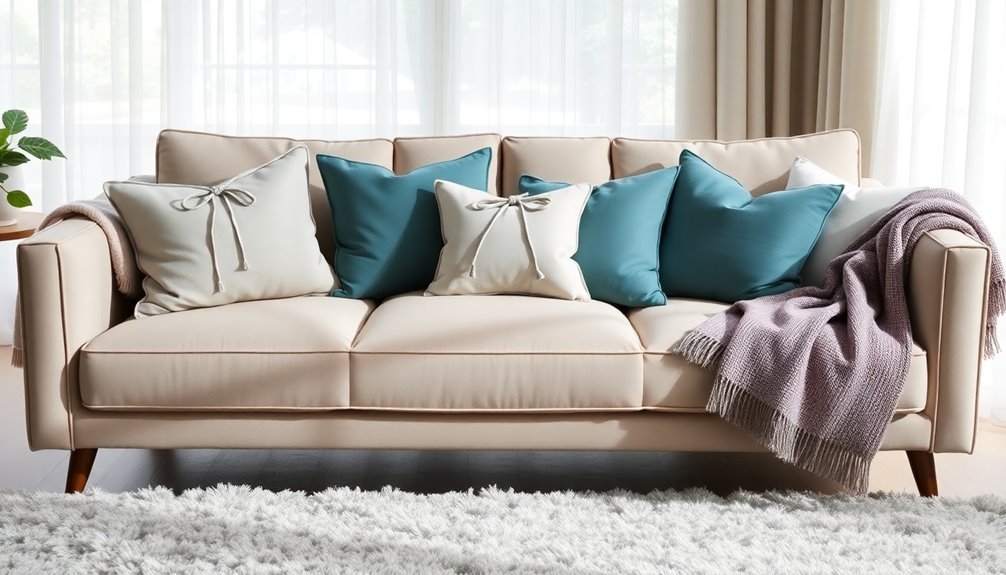
When it comes to cushion replacement options, you should consider the integrity of your sofa's frame and how it affects cushion stability. If you're looking to upgrade, choosing firmer cushions can enhance support and reduce movement. Don't forget about leather repair and conditioning, as maintaining the upholstery can also play a role in keeping your cushions in place.
Cushion Frame Integrity Concerns
A solid cushion frame is crucial for keeping your back cushions in place, as any wear or damage can lead to instability and sliding. Regularly inspect the frame of the couch for signs of wear, like cracks or loose joints. If you notice any issues, consider reinforcing or repairing the frame to enhance its integrity.
Replacement options for a compromised cushion frame include adding support structures such as plywood or brackets. These additions can significantly improve stability and prevent your cushions from sliding out of place. You might also think about upgrading to high-density foam cushions, which not only enhance comfort but also fit snugly within the frame of the couch, further helping to keep back cushions in their rightful position.
When replacing cushions, it's essential to measure the existing frame dimensions. This ensures that new cushions fit properly and provide adequate support, maintaining the stability of your back cushions. By prioritizing the integrity of your cushion frame, you can effectively keep your back cushions secure and enjoy a more comfortable seating experience.
Leather Repair and Conditioning
Leather repair and conditioning can significantly enhance the longevity and appearance of your sofa's back cushions. If your leather couch shows signs of wear, using high-quality leather repair and conditioning products can restore its suppleness and aesthetic appeal. These products not only improve the look of your cushions but also prolong their lifespan, ensuring they remain comfortable and visually pleasing.
When considering cushion replacement options, make sure to choose leather that matches your existing upholstery in color, texture, and durability. This will help keep couch cushions looking seamless and cohesive. Additionally, applying leather conditioners can prevent cracking and fading, maintaining the material's integrity while enhancing its resistance to stains and spills.
Before you replace your back cushions, assess the sofa's frame and structure. This step is crucial to ensure compatibility with new cushions and to support proper fit and functionality. If you're unsure about the process, professional leather repair services can provide valuable assistance. They can effectively address any damage while preserving the overall design of your leather couch, making it a worthwhile investment in the long run.
Cushion Upgrade for Enhanced Support
Upgrading your sofa's back cushions can make a significant difference in comfort and support. High-density foam cushions are an excellent choice as they provide better support and reduce shifting. These cushions maintain their shape and offer a firmer feel compared to traditional filler materials. If you prefer a softer touch, consider cushions with a wrapped fiber or down blend, which enhance comfort while keeping them securely in place.
Another effective option is to select cushions with built-in Velcro or hook and loop attachments. These features help prevent movement by securing the cushions to the sofa frame, ensuring they don't slide around. Additionally, look for cushions designed to fit snugly within your couch's backrest framework. This tailored fit minimizes sliding and improves the overall aesthetic of your furniture.
If you want the best possible result, consider investing in custom-made back cushions specifically designed for your sofa model. This guarantees a perfect fit and enhanced stability while still providing the comfort you desire. Upgrading your cushions not only boosts support but also elevates your entire living space.
Cushion Size Adjustments
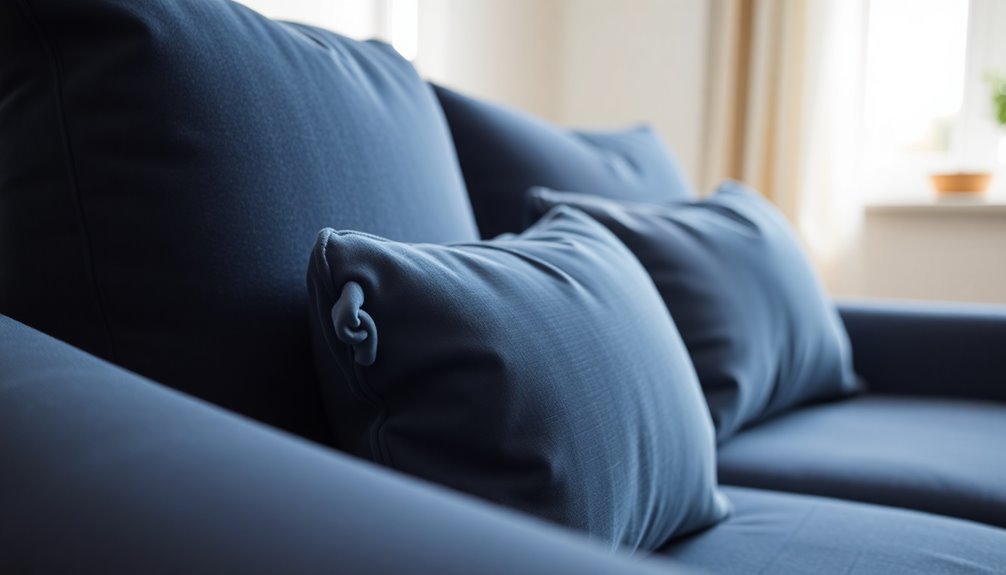
Finding the right fit for your sofa's back cushions is essential for keeping them in place. Start by measuring your cushions and comparing those dimensions with your sofa's backrest size. A snug fit can significantly reduce the chances of sliding cushions. If your cushions are too small, consider adding foam inserts or filler to enhance their size, allowing them to press firmly against the backrest.
On the other hand, oversized cushions can create instability. Trimming down the edges to match your sofa's dimensions can help ensure a more secure fit. Additionally, using non-slip pads between the cushions and the back of the couch can bolster their position, especially if they're slightly smaller than intended.
Regularly assessing your cushions for proper size can prevent unwanted movement and enhance your sofa's comfort. A little effort in adjusting their size can go a long way in maintaining a tidy and inviting living space. By focusing on these cushion size adjustments, you'll find that your back cushions stay in place, providing both support and a polished look to your couch.
Routine Cushion Fluffing
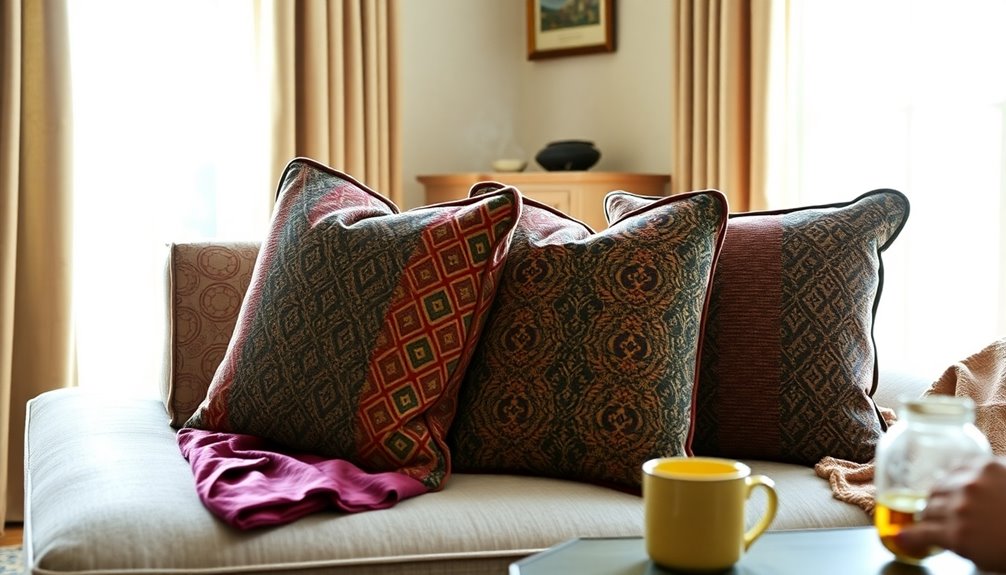
Fluffing your back cushions regularly is key to keeping them in shape and preventing sagging. Aim to fluff them at least once a week. This simple habit allows the fibers to regain their loft and resilience, enhancing both comfort and appearance. You'll notice how much longer your cushions last with this routine!
When you start fluffing, use your hands to gently knead and reshape the cushions. This action helps ensure that the filling is evenly distributed, providing optimal support. You might also want to rotate the cushions occasionally, which can prevent uneven wear and maintain a consistent look across your sofa.
Consider using cushion covers made of higher friction material. This can help keep the cushions in place while still allowing for easy fluffing and maintenance. By incorporating these practices into your weekly routine, you'll not only keep your cushions looking fresh but also enhance your overall lounging experience. Remember, a bit of effort in fluffing goes a long way in maintaining the beauty and functionality of your sofa. Keep those cushions in place, and enjoy a comfy, stylish living space!
Conclusion
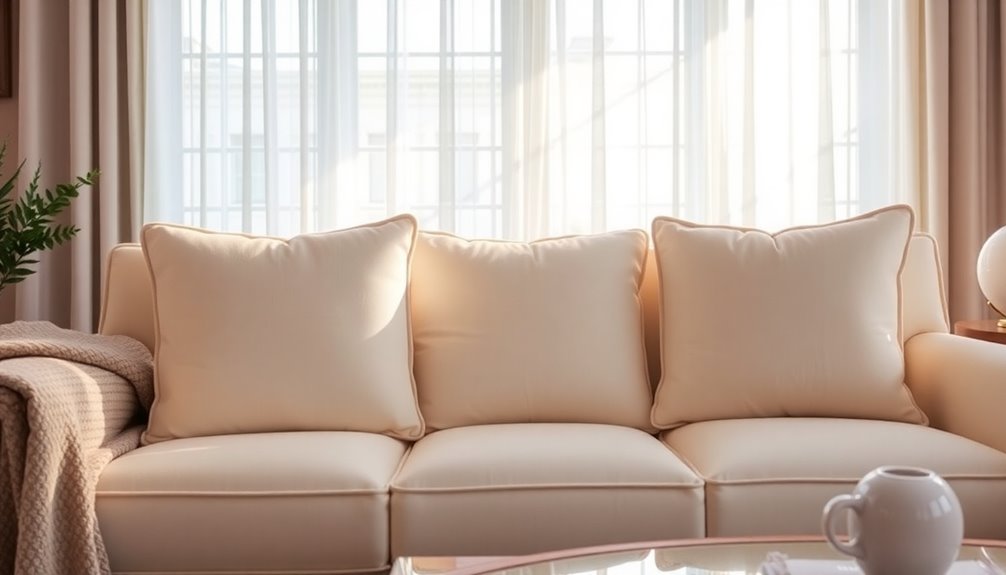
Maintaining the position of your sofa back cushions is essential for both comfort and aesthetics. By implementing a few simple strategies, you can ensure your cushions stay put and look great. One effective method is to use Velcro, which you can easily apply to both the cushions and the sofa for secure attachment. This way, your cushions won't shift around during everyday use.
Additionally, consider placing non-slip pads behind your back cushions. These create friction, helping them stay in place while you relax. A snug-fitting couch cover can also work wonders, holding the cushions securely while protecting against stains and wear.
If you're seeking a more permanent solution, sewing hooks onto your cushions and attaching rings to the couch can keep everything firmly in position, while still allowing for rotation when needed. Regularly assessing and adjusting your cushions is crucial, especially with materials that may naturally shift over time.
Frequently Asked Questions
How Do I Keep My Couch Back Cushions From Moving?
You want your couch back cushions to stay put, and there are several ways to tackle this. First, try using hook and loop anchor strips to attach the cushions to the couch. If that doesn't work, consider placing a non-slip pad or rubber drawer liner between them. Couch covers can also help, ensuring a snug fit. For a more permanent solution, sewing hooks and rings might keep everything in place effortlessly. Regular adjustments can help too!
How to Secure Couch Back Cushions?
To secure your couch back cushions, you've got a few effective options. First, try using hook and loop anchor strips, which create a strong connection between the cushions and the couch. Non-slip pads can also help by increasing friction, preventing any sliding. If you're handy, consider sewing a hook and ring system for easy rotation without flipping. Lastly, a couch cover paired with non-slip pads offers extra stability while protecting your upholstery.
How to Fix Couch Cushions That Won't Stay in Place?
If your couch cushions won't stay in place, start by checking for non-slip options. You can use heavy-duty hook and loop tape or non-slip pads underneath to create friction. Consider sewing a hook and ring system to allow for easy rotation without flipping. Regularly adjust the cushions as they can shift over time. Remember, couch covers can also help keep everything in place while protecting your upholstery.
How to Stop Sofa Back Cushions From Sagging?
To stop your sofa back cushions from sagging, try adding high-density foam to replace any worn-out filling. Regularly fluff and rotate the cushions to keep them evenly worn and maintain their shape. You can also place a non-slip pad between the cushions and the sofa for added friction. Finally, consider investing in a snug couch cover that can help hold everything in place while protecting against wear and tear.
